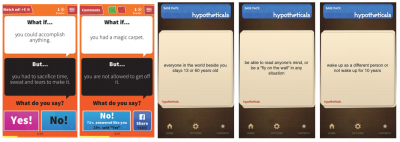What If/OG
| What If | |
| Contributors | Christian Kohls |
|---|---|
| Last modification | June 6, 2017 |
| Source | Kohls (2016)[1] |
| Pattern formats | OPR Alexandrian |
| Usability | |
| Learning domain | |
| Stakeholders | |
Also Known As: Challenge Assumptions (Challenge Assumptions)
You are trying to solve a problem but under the given conditions there simply is no way out.
Very often we constrain ourselves, our problem space and our solution space by incorrect assumptions.
Habits and rules are often conditioned and not questioned. However, if we start with wrong assumptions, the solutions are often poorly constructed[2]. We often derive rules and causalities that are wrong because our mind constructs patterns all the time. If our actions are based on the wrong rules we will come up with insufficient solutions. Many people consider challenges and situations as closed and constrained by rules instead of open solution spaces[3]. Our culture has taught us to follow existing rules rather than question them. Many of the rules that we follow have been meaningful once but are now outdated since the environment has changed. Yet we still follow them because we are used to them. But if we follow established rules we may stick to the wrong approach without generating alternative thoughts.
Therefore, challenge existing assumptions and ask “What if…” questions.
- State your current goal
- List all assumptions that you currently hold about your problem and solution space. Run a Brainstorming (Brainstorming) session or create an Attribute List (Attribute List) to state the assumptions.
- Challenge each assumption by asking “What if...”, negate the assumption, exaggerate the assumption, state the opposite, etc.
- Discuss: what would be the consequences if the rule was not followed? How could this be achieved?
- See: Ignoring existing rules or get rid of wrong assumption will open new paths.
Examples
- What if…we had unlimited budgets?
- What if…we had a team of 100? …or a team of only 2?
- What if…a week had 12 days?
- What if…cash money would no longer exist?
- What if…humans could fly?
- What if…your product distributed for free? ...or each item costs a million dollar?
- What if…penguins were pets?
- What if…everyone could program?
- What if…your product would be ten times larger? …or 1000 times smaller?
- What if…there was only one language in the world?
- What if…no meeting lasts longer than five minutes?
- What if…you could read ten books every day?
- What if…there is no sales department anymore?
- What if…products were delivered before they are produced?
- What if…you had only a pen to develop a new product?
- What if…
Find yourself five more what if… questions that challenge existing assumptions!
One way to find to challenge your own assumptions is to follow the principle of counterinduction. While induction infers assumptions based on empirical events, a counterinduction is assuming exactly the opposite of a hypotheses or an observation[4]. The method fosters progress by asking for alternative explanations. Even if we have working theory today, we may find a better one tomorrow. Such departure from obvious reasoning may not lead directly to new insights but it opens or mind for alternative reasoning, and may lead to indirect discoveries because it asks for new sense making. For example: Whenever I drop a penny it falls down. The inductive conclusion would be that the next time I drop the penny it also falls down. The counterinduction would be that the next time the penny will raise up or stay in the air. Now, under which conditions will the penny actually stay in air?
Looking for the opposite of a fact or theory is already thought-provoking in itself. For example, what is the opposite of a frog? Is it a dead frog? Is it a stork? Is it a car? This example was inspired from discussions with Till Schümmer. At EuroPLoP 2015 we had a design workshop where we used pattern cards (pattern thumbnails) and deliberately inverted the patterns: one online community pattern is “Registration”. The inverse could be a community with “No registration” which leads to new requirements.
Such creation of non-logical assumptions and hypotheses will automatically force you to explore new options and new ways of thinking. Try to identify all the rules, theories, attitudes and assumptions that your action is based on. Challenge each single one by reversing it or stop applying it.
Digital tools that ask what if questions.
References
- ↑ Kohls, C. (2016). Creativity patterns: 5 Habits. In Proceedings of the 10th Travelling Conference on Pattern Languages of Programs (VikingPLoP 2016) (p. 9). New York:ACM.
- ↑ Michalko, M. (2006). Thinkertoys: A handbook of creative-thinking techniques. Berkeley, Calif: Ten Speed.
- ↑ Von Oech, R. (2008). A Whack on the Side of the Head: How to Unlock Your Mind for Innovation. New York, NY: Grand Central Publishing.
- ↑ Feyerabend, P. (1975). Against method: Outline of an anarchistic theory of knowledge. London: NLB.
